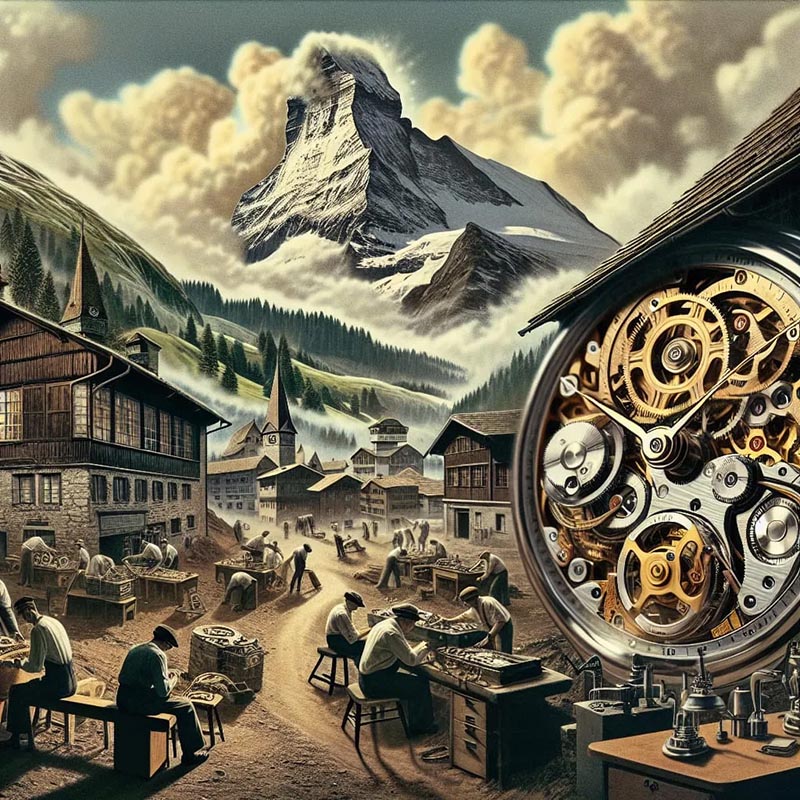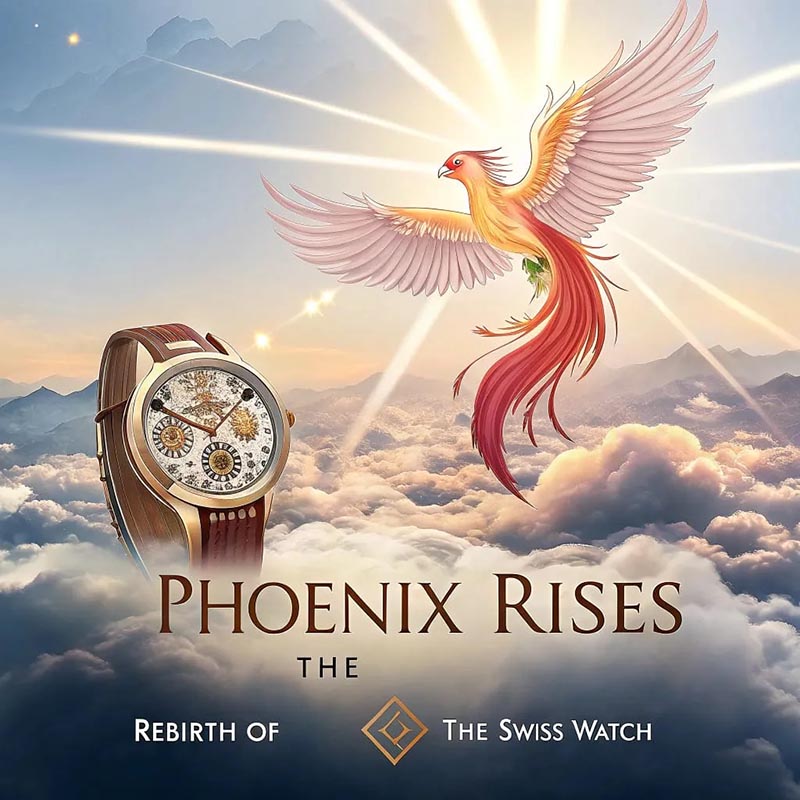In the heart of Europe, nestled among the snow-capped Alps, lies a country that has long been synonymous with precision, luxury, and the gentle ticking of time itself. Switzerland, the land of chocolate, neutrality, and clockwork precision, has a story to tell – a story of its illustrious watch industry. This is a tale that spans centuries, a narrative of artistry and innovation, of triumph and near-defeat, of tradition facing off against the relentless march of technology. It’s a story that, like the finest Swiss timepiece, is intricate, complex, and utterly fascinating.
The Seeds of Timekeeping: Early Beginnings
Our story begins not with watches, but with clocks. In the 16th century, French Protestant refugees, fleeing religious persecution, brought their clockmaking skills to Geneva. These Huguenot artisans found a welcoming home in the Swiss city, and their expertise laid the foundation for what would become a horological empire.

Did you know? The Geneva Clock Making Edict of 1601 officially recognized watchmaking as a profession, marking the beginning of Switzerland’s journey to become the watchmaking capital of the world.
As the years ticked by, Swiss craftsmen honed their skills, developing new techniques and pushing the boundaries of what was possible in timekeeping. The Swiss reputation for quality and precision began to grow, slowly but surely, like the steady movement of a clock’s hands.
The Golden Age: When Switzerland Ruled Time
Fast forward to the 19th century. Picture Geneva’s narrow cobblestone streets echoing with the soft clicks of watchmakers’ tools. In workshops bathed in natural light, skilled artisans hunched over benches, their steady hands assembling tiny gears and springs with a precision that would come to define Swiss craftsmanship.

By this time, Swiss watches had become more than mere timekeepers; they were works of art, coveted symbols of status and precision. The likes of Patek Philippe, Vacheron Constantin, and Jaeger-LeCoultre were creating timepieces that were as much about artistry as they were about telling time.
Did you know? The world’s first wristwatch was created by Patek Philippe for Countess Koscowicz of Hungary in 1868. Before this, watches were primarily pocket watches.
The Secret Behind Swiss Success
Several factors contributed to Switzerland’s dominance in the world of horology:
- Generations of skilled artisans passing down their craft like a precious heirloom, ensuring a continuity of expertise
- A spirit of innovation that gave birth to revolutionary concepts like the self-winding watch and the first waterproof timepiece
- Marketing genius that turned Swiss watches into must-have luxury items, symbols of success and sophistication
- Switzerland’s neutrality during world wars, allowing its watchmaking industry to thrive while others faltered
- The establishment of rigorous standards and certifications, like the Geneva Seal, which guaranteed quality and helped build trust in Swiss timepieces
By the early 20th century, Switzerland was producing more than 90% of the world’s watches. The country had become synonymous with precision timekeeping, a reputation it guarded as zealously as its famous bank secrecy laws.

Innovation and Expansion: The Mid-20th Century Boom
The post-World War II era saw a boom in the Swiss watch industry. As the world recovered from the ravages of war, there was a growing appetite for luxury goods, and Swiss watches were perfectly positioned to meet this demand.
This period saw remarkable innovations:
- In 1945, Rolex introduced the Datejust, the first self-winding wristwatch with a date window
- 1957 saw the launch of the Omega Speedmaster, which would later become the first watch worn on the moon
- In 1967, the Centre Electronique Horloger in Neuchâtel developed the first quartz wristwatch prototype, the Beta 1
Interesting fact: The Omega Speedmaster, worn by Buzz Aldrin during the Apollo 11 mission, is often referred to as the “Moonwatch”. It’s still part of NASA’s approved equipment for space missions.
Swiss watchmakers were at the forefront of horological innovation, seemingly unstoppable in their dominance of the global watch market. But as the saying goes, pride comes before a fall, and the Swiss watch industry was about to face its greatest challenge yet.
The Quartz Crisis: When Time Stood Still
The 1970s brought a seismic shift to the world of horology. From the Land of the Rising Sun came a new challenger that would shake the Swiss watch industry to its very core: the quartz watch.

Interesting fact: The first quartz wristwatch, the Seiko Astron, was released on Christmas Day, 1969, at a price equivalent to a medium-sized car. Despite its high initial cost, it signaled the beginning of a new era in watchmaking.
The Ticking Time Bomb
Like a perfectly orchestrated Swiss movement, several factors aligned to create the perfect storm:
- Japanese manufacturers, led by Seiko and Casio, flooded the market with accurate, affordable quartz watches
- The global economy stumbled, making luxury mechanical watches seem like frivolous indulgences
- Swiss watchmakers, proud of their mechanical mastery, initially scoffed at the “soulless” quartz technology, failing to recognize its potential
- The strong Swiss franc made exports more expensive, further hampering sales
The result was catastrophic. Swiss watch exports plummeted from 40 million units in 1973 to just 10 million a decade later. Venerable companies closed their doors. The Jura valleys, once echoing with the sounds of ticking watches, fell eerily silent. Between 1970 and 1988, the number of watchmaking employees in Switzerland fell from 90,000 to 28,000.
The term “Quartz Crisis” is also known as the “Quartz Revolution” in Japan, highlighting how perspective can shape historical narrative.
It seemed that the era of Swiss dominance in watchmaking had come to an end. Many predicted that the industry, like the mechanical watches it produced, had become a relic of the past. But those making such predictions had underestimated Swiss resilience and ingenuity.
The Phoenix Rises: Rebirth of the Swiss Watch
Just when it seemed that the Swiss watch industry was destined to become a footnote in horological history, a remarkable turnaround began. Like a finely crafted timepiece, the industry refused to stop. It reinvented itself, blending tradition with innovation in a way only the Swiss could.

The Comeback Strategy
The revival of the Swiss watch industry was a masterclass in adaptation and marketing:
- Embracing quartz technology while preserving the art of mechanical watchmaking, creating a two-pronged approach to the market
- The birth of Swatch in 1983 – affordable, fashionable quartz watches that captured the world’s imagination and helped fund the recovery of the broader Swiss watch industry
- Doubling down on luxury, turning high-end mechanical watches into collectible works of art and status symbols
- Leveraging centuries of heritage to create powerful brand stories that resonated with consumers seeking authenticity and tradition
- Consolidation of brands under larger groups, like what would become the Swatch Group, to share resources and strengthen market position
Fun fact: The name “Swatch” is a contraction of “Second Watch,” as the timepieces were intended to be casual, disposable accessories. Ironically, many Swatch watches have now become collectibles.
The strategy paid off. By the late 1990s, Swiss watches were once again desired objects, with high-end mechanical timepieces becoming powerful symbols of luxury and success.
The Mechanical Renaissance
Perhaps the most surprising aspect of the Swiss comeback was the renewed interest in mechanical watches. In an age of digital precision, there was a growing appreciation for the artistry and tradition embodied in a finely crafted mechanical timepiece.
Brands like Patek Philippe, Rolex, and Audemars Piguet positioned their mechanical watches as the antithesis of disposable consumer culture. These weren’t just timekeepers; they were heirlooms to be passed down through generations, embodying craftsmanship, history, and emotional value that a mass-produced quartz watch could never match.
In 1999, the Patek Philippe advertisement campaign “You never actually own a Patek Philippe. You merely look after it for the next generation” perfectly encapsulated this sentiment and became one of the most successful luxury marketing campaigns in history.
The 21st Century: New Challenges and Opportunities
As the new millennium dawned, the Swiss watch industry found itself in a position of strength once again. But the world of horology continued to evolve, presenting new challenges and opportunities:
The Rise of Smartwatches
Just as the industry had recovered from the quartz crisis, a new technological threat emerged: the smartwatch. With the launch of the Apple Watch in 2015, some predicted another crisis for traditional watchmakers.
However, the Swiss industry, having learned from the quartz crisis, was quicker to adapt this time. Brands like TAG Heuer and Montblanc launched their own smartwatches, while others doubled down on the emotional and aesthetic appeal of traditional timepieces.
Changing Consumer Preferences
The 21st century has seen significant shifts in consumer behavior:
- Younger generations often view time differently, preferring experiences over possessions
- There’s a growing interest in the stories behind products, benefiting brands with rich histories
- Sustainability and ethical production have become important factors in purchasing decisions
Swiss brands have responded by emphasizing their heritage, improving transparency in their supply chains, and in some cases, embracing new materials and production methods to appeal to environmentally conscious consumers.
The Impact of E-commerce and Social Media
The digital revolution has transformed how watches are marketed and sold. Social media platforms have become crucial for brand building, with “watch influencers” wielding significant influence over consumer preferences.
E-commerce has also disrupted traditional sales channels, forcing brands to reconsider their distribution strategies. Some high-end brands have cautiously embraced online sales, while others maintain that the experience of purchasing a luxury timepiece cannot be replicated online.
The Future: Time Waits for No One
As we look to the future, the Swiss watch industry faces both challenges and opportunities:
- Smartwatches continue to evolve, potentially attracting younger consumers away from traditional timepieces
- Economic uncertainties and global events like the COVID-19 pandemic can impact luxury spending
- The industry grapples with sustainability, balancing traditional craftsmanship with environmental concerns
- Emerging markets, particularly in Asia, offer new growth opportunities
- Advances in materials science and production techniques open up new possibilities in watchmaking
Yet, if history is any guide, the Swiss watch industry will likely continue to adapt and thrive. The very qualities that have defined Swiss watchmaking – precision, innovation, and an unwavering commitment to quality – are the same qualities that will likely ensure its continued success.
Conclusion: The Eternal Tick
The story of the Swiss watch industry is more than a tale of gears and springs. It’s a testament to human ingenuity, the power of tradition, and the ability to adapt in the face of adversity. From its humble beginnings in the workshops of Geneva to its global dominance, near-collapse, and remarkable resurgence, the industry has time and again demonstrated its resilience.
As we look to the future, one thing is certain: whatever challenges may come, the Swiss will face them with the precision, creativity, and resilience that have defined their industry for centuries. In a world of constant change, there’s something reassuring about the steady tick of a Swiss watch – a small, mechanical marvel that continues to capture our imaginations and measure our most precious resource: time.
In the end, perhaps the greatest lesson from this horological saga is that true craftsmanship, like time itself, is eternal. The Swiss watch industry may have faced its darkest hour, but it emerged, ticking stronger than ever, ready to face whatever the future may bring. As long as humans value the artistry, history, and emotion embodied in a finely crafted timepiece, there will always be a place for Swiss watches in our world.
As Nicolas Hayek, the savior of the Swiss watch industry and founder of Swatch Group, once said: “We’re not in the watch business. We’re in the emotional business.” This understanding – that a watch is more than just a timekeeper – may well be the key to the industry’s continued success in the years to come.

